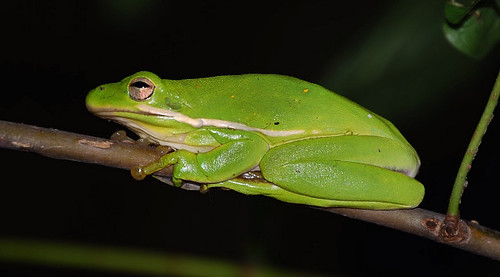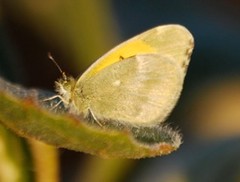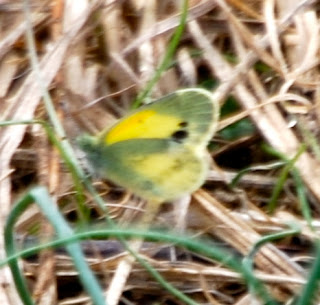The report that there were as many as fifty Dainty Sulphurs (Nathalis iole) present at a north Georgia location was big news. There were no previous documented records for that species in the Ridge & Valley prior to 2010. In fact, there were only nine Georgia counties that sported documented records. To have such a large number concentrated at one site was a surprise. The discovery was made on November 1st, 2010 along Fite Bend Rd. in Gordon County. This road cuts through large crop fields which are rotated between corn, sunflower, soybean, etc. from year to year. There were two main groups found along the road. Darlene Moore and Roy Brown located the first of at least thirty individuals and Max Medley located another group about half of a mile further south. This last group numbered at least twenty individuals. Photos - http://www.flickr.com/photos/rbinv/5137519954/in/set-72157624310847802/
None were observed nectaring on the blooms present. One male was observed making an effort to copulate with a female. The female's wings possibly suggest that she had recently emerged. It would be assumed that there is a thriving colony in this area, but this assumption may be premature due to this butterfly's nature to migrate. Consequently, the migration is usually limited to spring and summer. The high number is so impressive that one must consider the possibility that these were Gordon County residents. Lucien Harris (1972) describes his experience with colonies: "It (Nathalis iole) is very local, but when a colony is found, it usually contains a number of adults, often flying actively about over a rather limited area." This is similar to the experience that Darlene Moore, Roy Brown, and Max Medley had on Fite Bend Rd. To determine if a permanent colony was established here, further evidence would need to be observed in the years to come. A compilation of plants was made here and is being reviewed to determine if any would act as host species for the Dainty Sulphur.
Interestingly, there was some suspicion that there possibly could have been an increase/shift with this species over the last few months. I personally had observed it on four other occasions, three of which were new county records for Gordon, Cobb, and Troup counties.
The first was an individual spotted by Max Medley on 9/12/10 in eastern Gordon County(along the Coosawattee River).
The second was an individual I photographed on 10/18/10 in Cobb County(along the Chattahoochee River).
The third was an incidental sighting in Gordon County on 10/26/10.
The fourth was an individual I photographed in Troup County(also along the Chattahoochee River) on 10/28/10.
Photographed specimens will be added to the other nine documented records which include: Bibb, Fulton, DeKalb, Clarke, and Monroe in the Piedmont and Chatham, Glynn, and Camden on the coast. I have no information on whether the record from Crawford County was above or below the fall-line. There are also some sight records from around the state, but these are few.
Other 2010 observations of this species include:
8/7/10 - 16 individuals (Some were nectaring on Helenium armarum (Bitterweed)- Rockdale County - Panola Mtn State Park - Jerry Payne, Alice Jordon, Charlie Seabrook, Phil Delestrez, Rose Payne
9/14/10 - DeKalb County - Stone Mountain Memorial Park - Jerry Payne, Naomi Thompson and Martha Delestrez (Lucien Harris discovered a colony here on August 2nd, 1952)
10/9/10 - 3 individuals (One was nectaring on Aster dumosus) - Bibb County - near Montpelier Station Rd. - Jerry Payne
10/9/10 - Gwinnett County - McDaniel Farm - Karen & Luke Theodorou - http://www.flickr.com/photos/lukethrush/5064754627/
10/17/10 - One nectaring on Polypremum procumbens (Rustweed) - Bibb County - near Montpelier Station Rd. - Jerry & Rose Payne Photographed by Rose.
http://picasaweb.google.com/108967381620126777731/20101017DaintySulphurMontpelierStationRd17Oct2010#
10/22/10 - 6 adults (some copulating) - Rockdale County - Monastery of the Holy Spirit - F.M. Stiteler, Jim Allison, Jerry Payne, Rose Payne
10/30/10 - 2 individuals (nectaring on Chrysopsis mariana (Maryland Golden Aster), Ageratina sp. (White Snakeroot) and Aster sp.) - Monroe County - Rum Creek WMA - Jerry & Rose Payne
10/31/10 - 2 individuals - Jones County - Piedmont Wildlife Refuge - Jerry & Rose Payne
11/01/10 - Jones County - Piedmont Wildlife Refuge - Jerry & Rose Payne
11/04/10 - Gordon County - Fite Bend Rd - Joshua Spence
11/10/10 - Jones County - Piedmont Wildlife Refuge - Jerry & Rose Payne
11/10/10 - Murray County - Davis Jones Rd - Joshua Spence
11/10/10 - Gordon County - Covington Bridge Rd - Joshua Spence
11/10/10 - 3 individuals - Gordon County - Fite Bend Rd - Joshua Spence
11/11/10 - 5 individuals - Stewart County - Bradley Unit - Roy Brown & Darlene Moore
11/11/10 - Clay County - Walter F. George - Eric & Michael Beohm - http://eaglecreek4.tripod.com/georgiabirdingandnature/id142.html
11/20/10 - Stewart County - Bradley Unit - Roy Brown & Bruce Horn
11/25/10 - Bibb County - near Montpelier Station Rd. - Jerry & Rose Payne
With all these observations combined, one has to wonder if this couldn't be a population explosion in comparison to its past status in Georgia. There has been discussion of whether most of these sightings were a product of migrant colonization. Some of the earlier sulphurs observed were the summer form and it has been suggested that these could have been in transit throughout the state. Most of the sulphurs observed were the winter form and it has been suggested that some of these could be offspring of the earlier summer forms. This is quite possible as there are no thriving GA interior disjunct populations known. At the same time, it is difficult to make assessments based on the lack of historical data and the low number of field observers statewide. Therefore, many questions surrounding populations cannot be answered with certainty. In other words, only time will tell.
One thing is for certain, and that is this has been a great fall for observing Dainty Sulphurs in Georgia.
The Dainty Sulphur (Nathalis iole) is a small butterfly that belongs to the Pieridae family. This species is quite common in the southwestern United States. Numbers seem to decrease east of the Mississippi River, except on the Florida peninsular where it has a year-round flight period. It is most often found in open, dry situations, such as coastal flats, meadows, grasslands, etc. This might explain their high occurrence status in states that are characterized by open habitat and likewise, their low occurrence status in the historically forested states of the east (see map: http://www.butterfliesandmoths.org/species?l=1458&chosen_state=* ). This butterfly apparently is unable to survive the frigid winters that limit its range in the north. The populations found throughout the Great Plains to southeast Washington, southeast Idaho, Wyoming, and Minnesota are products of annual recolonization.
More info at the link below:





